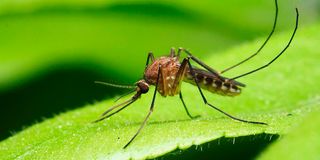Kemri deploys team to Marsabit to research on new malaria-causing mosquito

KemriI detected a new dangerous mosquito vector in Kenya on December 22, 2022.
A team from Kenya Medical Research Institute (Kemri), the Ministry of Health, and the Division for National Malaria Programme (DNMP) have pitched camp in Marsabit to study the behavioural adaptation of the newly detected mosquito vector to insecticide control.
Speaking to the Nation.Africa on phone, Marsabit Deputy Governor Solomon Gubo called for patience and caution from the residents as the Kemri-led medical crew pitches camp to undertake a one-week intense vector examination from Monday.
“We have been made aware of the one-week entomological surveillance of the recently detected Anopheles Stephensi mosquito species undertaken by medical experts in Saku and Laisamis sub-counties and we call on the public to exercise patience and caution as we wait for the outcome,” Mr Gubo said.
He said that the county government would grant the team all the necessary support to successfully execute their research.
Mr Gubo also appealed to the residents of the hotspot areas to take cautionary measures to avert malarial infections by sleeping under insecticide-treated nets, using repellants, and destroying all the potential breeding zones.
Additionally, proper ventilation of houses was required to prevent the attraction of mosquitoes.
He said research has also established that poorly ventilated houses attract more mosquitoes, hence contributing greatly to the spread of malaria.
This happens against the backdrop of fear hanging over Saku and Laisamis sub-counties following the recent report by Kemri that a new dangerous mosquito vector was detected in the county.
Residents of Marsabit especially in Saku and Laisamis sub-counties have been left with their blood cold following the announcement by KemriI that the newly detected mosquito was capable of highly transmitting malaria in urban and peri-urban settings.
Marsabit County Health Executove Grace Galmo revealed that there had been worrying incremental rates of malaria cases in Marsabit before the detection of new dangerous mosquitoes.
The worrying trend of malarial infections reported in the county spurred entomological surveillance in the county late last year.
She pointed out that the team was only able to detect the mosquito larvae instead of the adult ones which would have greatly aided their behavioural adaptation of the mosquito vectors to insecticide control.
She was optimistic that the renewed entomological surveillance would finally come up with effective vector control and management methods.
Further, experiments would also establish the genetic modifications to unveil how the dangerous mosquito lay unviable eggs.
According to the Kemri’s internal memo seen by the Nation, the Kemri Entomology Research team together with their colleagues from the Ministry of Health’s DNMP detected a new dangerous mosquito vector in Kenya on December 22, 2022.
The detection was made during routine mosquito surveillance in different counties across Kenya where a new malaria vector is known as Anopheles stephensi in Saku and Laisamis sub-counties in Marsabit where the samples were detected and confirmed through a laboratory at KEMRI.
The report until the detection of Anopheles Stephensi was known to occur and spread malaria in South-East Asia, the Middle East, and the Arabian Peninsula.
The mosquito species has been expanding its geographic range over the last decade, with detections being reported in Djibouti (2012), Ethiopia, Sudan (2016), Somalia (2019), and Nigeria (2020).
Recent detection
The report detailed the recent detection of Anopheles Stephensi posed far-reaching threats that could easily reverse gains made by Kenya in the fight against malaria.
“According to our surveillance studies, the new vector unlike the traditional malaria-causing mosquitoes namely Anopheles gambie and Anopheles funfests, is not invasive and can spread very fast to new areas, but also adaptive to different climatic and environmental conditions,” the report stated.
Anopheles stepehensi thrives in man-made containers such as jerry cans, tyres, open tanks, sewers, cisterns, overhead tanks, underground tanks and polluted environments.
Kemri however, urged the staff and the public to continue utilizing the available malaria control such as mosquito nets, repellants, and wearing long-sleeved clothing to prevent bites as they continue to conduct entomological surveillance in the hotspot counties.
Entomological surveillance is aimed at determining the extent of vector distribution and mosquito infectivity rates.
In the recent past bioengineers and tropical medicine experts globally have been left scratching their heads at the continued evolving resistance mechanisms of mosquitoes threatening the continued efficacy of insecticide-based strategies.
The experts warned that mosquitoes have also developed resistance to insecticides, including parathyroid which is commonly used for the treatment of mosquito nets.
The continued evolutions have seen new technologies to deal with mosquitoes such as the use of toxic sugar baits which are hung in containers to attract mosquitoes.
Some researchers have also been working day and night to come up with mosquito-blinding technologies to prevent them from smelling and detecting human beings.
Insecticides reduce mosquito fitness and defence mechanisms to aid resistance and tolerance to such insecticides.
According to Rice University (US) research, mosquitoes have behavioural exploitation or adaptation following physiological evolution (biochemical and morphological) resistance and thus they exploit recognition of the insecticides to their benefit.
To date, myriads of physiological resistance mechanisms to insecticides including biochemical and morphological have been discovered among mosquito species.
The anti-insecticide behaviours are categorized into three mechanisms including qualitative resistance which limits the potential contact with the insecticide, and quantitative resistance which stops, limits, or reduces insecticide action.
The third category includes tolerance behaviours which alleviate fitness reductions caused by insecticides.
Behavioural resistance to insecticides may be an important factor restraining the efficacy of vector control against mosquito-transmitted diseases.
The insects' bites can spread diseases like malaria, dengue, and yellow fever, but setting up experiments to examine their behaviour can take a big bite out of lab budgets.





